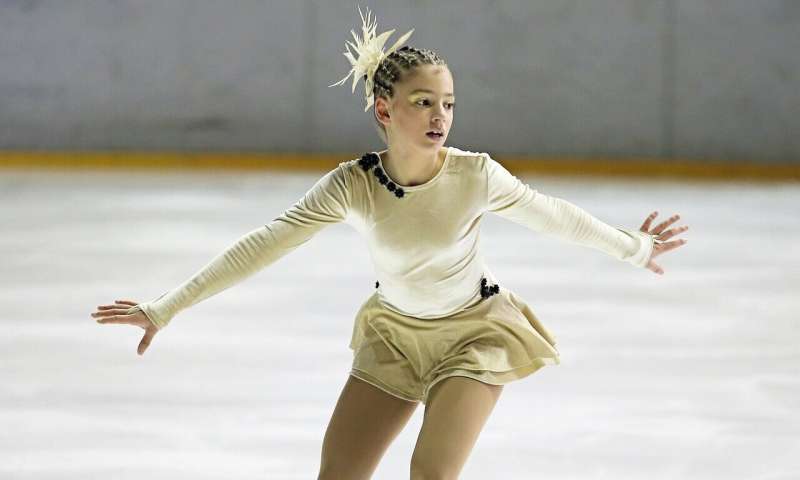
A new mathematical model developed by University of Alberta scientists shows how figure skaters move across the ice—and could help professional skaters hone their technique or prevent injuries.
"We can describe the motion of the figure skater," said Ph.D. student Meghan Hall. "If I want to make this movement or this pattern, what do I need to do with my body? What is the optimal way to do it? Or, if I'm not sure how to make a certain movement or pattern, this system will model the movement I need to make to produce it."
Hall, a recreational figure skater for 20 years, is conducting the research with fellow graduate student Vaughn Gzenda under the supervision of Vakhtang Putkaradze.
In the first of two studies, the scientists note that previous research has looked at the two-dimensional physics of figure skating, but their new model is the first to use nonholonomic mechanics, or mechanics with constraints, to show how a body moves on ice in three dimensions.
"It turns out that we can solve this problem by hand, which is incredible because equations in nonholonomic mechanics are very complex," said Putkaradze, who is currently the senior director of science and technology with ATCO's Transformation Team.
The second, upcoming study includes a library of all the various movements and trajectories a skater can take.
"The fact that the equations of motion are integrable, or completely solvable, is most surprising," said Gzenda. "Mechanical systems with nonholonomic constraints which are also integrable are exceedingly rare. There is a relatively short list of known examples—one example is a symmetrical rolling ball. Another is how a sleigh moves along a surface.
"Our model is, as far as we know, the newest on this list."
Practical applications
"Figure skating inspired this research project, and now the project inspires me when I'm on the ice," she said. "I've had a very different approach to skating throughout my career—probably because my head just thinks this way. Now we've built a simulation and I can see, on paper, how to shift my body."
In addition to inspiration on the ice, the research has potential practical applications for skaters and trainers alike, Putkaradze noted.
"This would be a great way to understand how people train and could contribute to better figure skating training," he said.
It could also help skaters avoid common injuries like spiral fractures in the lower leg.
"This could potentially apply to blade or boot design, or even technique to avoid these injuries," added Hall.
The first study, "Integrability and Chaos in Figure Skating," by Gzenda and Putkaradze, was published in the Journal of Nonlinear Sciences.
Explore further
Citation: Mathematicians reveal the science behind figure skating (2020, May 26) retrieved 26 May 2020 from https://ift.tt/2yw1ld8
This document is subject to copyright. Apart from any fair dealing for the purpose of private study or research, no part may be reproduced without the written permission. The content is provided for information purposes only.
"behind" - Google News
May 26, 2020 at 07:48PM
https://ift.tt/2yw1ld8
Mathematicians reveal the science behind figure skating - Phys.org
"behind" - Google News
https://ift.tt/2YqUhZP
https://ift.tt/2yko4c8
Bagikan Berita Ini














0 Response to "Mathematicians reveal the science behind figure skating - Phys.org"
Post a Comment